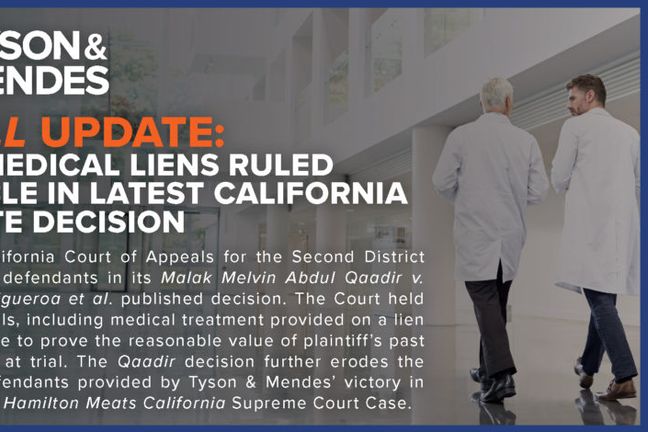Last week the California Court of Appeal issued another huge victory to defendants by extending the reach of the landmark California Supreme Court Howell v. Hamilton Meats case to include future medical benefits under the Patient Protection and Affordable Healthcare Act (“ACA”). In 2011, Howell sent shock waves through the insurance industry when the Court examined the “billed vs. paid” rule and concluded an injured plaintiff is limited to recovering the discounted amount private health insurance pays on their behalf for as past medical damages, not the inflated amount medical providers bill health insurance companies for their services. (Howell v. Hamilton Meats & Provisions, Inc. (2011) 52 Cal.4th 541.) In 2013, the California Court of Appeal extended Howell‘s “paid” rule to apply to future medical expenses and noneconomic damages. (Cornenbaum v. Lampkin (2013) 215 Cal.App.4th 1308, 1331-1333.)
Now, in the medical malpractice case of Cuevas v. Contra Costa County, the Court of Appeal for the First Appellate District held evidence of plaintiff’s future care benefits available through the ACA is admissible at trial. (Cuevas v. Contra Costa Cnty. (Cal. Ct. App., Apr. 27, 2017), No. A143440 2017 WL 1507913 at *1.) The Court found “the trial court erred in excluding evidence that health insurance benefits under the ACA would be available to mitigate Plaintiff’s future medical costs.” (Id.)
The Contra Costa Trial – ACA Evidence Excluded
The jury considered evidence at trial that plaintiff sustained irreversible brain damage in utero due to the treating doctor’s negligence in failing to schedule his delivery prior to 37 weeks’ gestation. (Id. at *2.) Specifically, plaintiff sustained a hypoxic brain injury and suffered cognitive disabilities rendering him dependent on others for care for the rest of his life. (Id.)
Plaintiff presented a life care plan prepared by Jan Roughan. (Id.) Plaintiff’s life care plan cost was based on inflated average medical charges billed from a national database. (Id. at *3.) This plan did not account for amounts medical providers would accept as payment in full under Howell and Cornenbaum, nor did the plan consider discounts available to plaintiff under insurance procured through the ACA. (Id.) Plaintiff’s life care plan totaled $285 million, with a present value of nearly $29 million. (Id. at *7.)
Alternatively, the defense life care planner, Linda Olzack, prepared a life care plan based on Howell‘s paid rule and future care recommended by defense medical experts. The defense plan included three different future medical cost scenarios assuming: (1) plaintiff would continue to receive coverage under Medi-Cal; (2) plaintiff would procure private insurance under the ACA; and (3) plaintiff would pay for future medical expenses out of pocket. (Id. at *3.) Additionally, the defense expert applied a defense value to plaintiff’s life care plan, which included future care the defense disputed was neither reasonable nor necessary. (Id.) As typically seen in California injury litigation, the defense life care plan was significantly less than plaintiff’s inflated values. Furthermore, the defense presented an expert on the ACA and regulatory health care policy, Thomas J. Dawson, who negotiated provisions of the legislation in support of instruction of ACA benefits at trial. (Id. at *4.)
Before trial, the court ruled the defense could not introduce evidence of ACA or Medi-Cal insurance benefits based on Civil Code section 3333.1 (“section 3333.1”), a statute contained within the Medical Injury Compensation Reform Act (“MICRA”). (Id.) As a result, the defense life care planning expert was only allowed to testify regarding amounts plaintiff would pay for future medical expenses out of pocket – approximately $3.3 million. (Id. at *7.)
The jury found for plaintiff on liability and causation and awarded plaintiff $100 million for future medical care, reduced to present cash value of approximately $9.6 million. (Id. at *4, 7.) Defendant appealed, claiming the defense life care planner would have testified to a much lower amount had the jury been permitted to consider evidence regarding Medi-Cal payments or private health insurance benefits procured through the ACA.
Court of Appeal Reverses Trial Court – Future ACA Benefits Admissible
Evidence of ACA Future Benefits Admissible Under MICRA
Upon appellate review, the Court extended the Howell paid rule to apply to future medical benefits available under the ACA in medical malpractice cases. The Court first analyzed MICRA’s regulations regarding future medical expenses.[1]
Section 3333.1 alters the collateral source rule in medical malpractice cases by allowing the jury to consider future medical benefits available when assessing future medical damages. (Cuevas, supra, at *9.) Specifically, a medical malpractice defendant may introduce evidence at trial of:
any amount payable as a benefit to the plaintiff as a result of the personal injury pursuant to the United States Social Security Act, any state or federal income disability or worker’s compensation act, any health, sickness or income-disability insurance, accident insurance that provides health benefits or income-disability coverage, and any contract or agreement of any group, organization, partnership, or corporation to provide, pay for, or reimburse the cost of medical, hospital, dental, or other health care services.
(Section 3333.1, subd. (a), fn. omitted.)[2]
Despite an ambiguity regarding the term “amount payable” in section 3333.1, the Court concluded the legislature did not intend to restrict evidence at trial to only health care benefits available for past medical expenses. The Court explained, “[i]nterpreting the statute as abrogating the collateral source rule with respect to future medical benefits as well as past benefits is consistent with the legislative purpose of reducing malpractice insurance costs.” (Id. at *15.)
Admission of ACA Benefits is Consistent with Howell and its Progeny
The Court also agreed with defendant’s proposition that like the negotiated payment amounts in Howell, the amounts paid by the ACA are highly probative in determining the reasonable value of the plaintiff’s medical damages. (Id. at *17.) Moreover, permitting evidence of ACA benefits aligns with Corenbaum, in which the court held “evidence of the full amount billed for a plaintiff’s medical care is not relevant to damages for future medical care or noneconomic damages[.]” (Corenbaum, supra, 215 Cal.App.4th at 1333.) Lastly, the Court noted a recent case from the Second Appellate District, Markow v. Rosner (2016) 3 Cal.App.5th 1027, which cites to Howell and Corenbaum: “For insurance plaintiffs, the reasonable market or exchange value of medical services will not be the amount billed by a medical provider or hospital, but the ‘the amount paid pursuant to the reduced rate negotiated by the plaintiff’s insurance company.’”
The ACA Is Still Valid Law and Its Benefits Cannot Be Excluded
Furthermore, the Court knocked down the trial court’s conclusion that evidence of future benefits to plaintiff under the ACA were inadmissible based on the precarious position of the ACA’s survival. The Court concluded, “the trial court’s decision to exclude evidence of future insurance benefits that might be available under the ACA on the basis that the ACA is unlikely to continue was abuse of discretion.” (Cuevas, supra, at *20.) Despite the tumultuous 2016 presidential election and President Trump’s January 20, 2017 Executive Order announcing his policy to swiftly repeal the ACA, the ACA still stands as valid law. The Court noted defendant’s expert presented evidence and “opined that the ACA is reasonably certain to continue well into the future and that plaintiff will be able to acquire comprehensive health insurance notwithstanding his disability.” (Id.)
Takeaways
The Cuevas case reinforces defense strategy recommended by Tyson & Mendes in both medical malpractice and broader personal injury litigation. First, defense life care planners must be qualified to render opinions on the ACA and its application to plaintiff’s alleged future care. Second, the defense life care planner should prepare multiple cost scenarios to defense medical expert future care recommendations, including available government or workers’ compensation benefits, private health insurance available under the ACA, and cash pay. The defense expert should also determine a defense reasonable value for each of alleged future medical service contained in plaintiff’s life care plan. Third, consider retaining an ACA expert to support defense arguments on the applicability of such benefits in the face of plaintiff’s collateral source arguments. Finally, defense counsel must be prepared to argue applicability of the ACA and other available future benefits and object to plaintiff’s introduction of inflated medical expenses that do not consider amounts providers accept as payment in full at trial.
Tyson & Mendes is encouraged by the First District’s interpretation of Howell and the ACA in Cuevas. Cuevas reaffirms Howell is here to stay!
Contact Special Counsel Cayce Greiner at cgreiner@tysonmendes.com with Howell or other medical damages questions.
[1] Notably, California’s MICRA statute, enacted in 1975, caps noneconomic damages in medical malpractice cases at $250,000. (Cal. Civ. Code § 3333.2.)
[2] Courts have held section 3333.1 does not apply to Medi-Cal payments made on behalf of a medical malpractice plaintiff. (Hernandez v. California Hospital Medical Center (2000) 78 Cal.App.4th 498, 506; Brown v. Stewart (1982) 129 Cal.App.3d 331, 341.) Accordingly, the Cuevas Court concluded “the collateral source rule continues to apply in medical malpractice cases as to Medi-Cal payments.” (Cuevas, supra, at 10.)
Download Article Here: Howell Update: Another Victory for Defendants

 Author: Cayce E. Lynch
Author: Cayce E. Lynch
 Cannabis Workers Allege Quota to Trim 4 Pounds a Day Violates the California Labor Code
Cannabis Workers Allege Quota to Trim 4 Pounds a Day Violates the California Labor Code
 The Ninth Circuit Reminds Us: Every Word Matters
The Ninth Circuit Reminds Us: Every Word Matters
 NO WAY, PRO SE! The Consequences of Abusing the Judicial System as a Pro Se Litigant in Colorado
NO WAY, PRO SE! The Consequences of Abusing the Judicial System as a Pro Se Litigant in Colorado
 Victim of Financial Mismanagement or Unlawful Retaliation? New Jersey City University Program Founder Claims School Retaliated After Reporting Alleged Sexual Harassment
Victim of Financial Mismanagement or Unlawful Retaliation? New Jersey City University Program Founder Claims School Retaliated After Reporting Alleged Sexual Harassment
 “Real Housewives” Gets a Reality Check
“Real Housewives” Gets a Reality Check
 Missing a Chapter: Insufficiency of Expert Deposition Testimony in Medical Malpractice Litigation
Missing a Chapter: Insufficiency of Expert Deposition Testimony in Medical Malpractice Litigation
 Crash Course: Why Summary Judgment Misses the Mark in Illinois Multi-Cause Limousine Crash Collision
Crash Course: Why Summary Judgment Misses the Mark in Illinois Multi-Cause Limousine Crash Collision
 Bitter Truths: Lead, Cadmium, and Defective Pleadings in California Chocolate Class Action
Bitter Truths: Lead, Cadmium, and Defective Pleadings in California Chocolate Class Action
 The Law of Unintended Consequences: Including Insurance Brokers in Litigation Strategy Communication May Waive the Attorney-Client Privilege
The Law of Unintended Consequences: Including Insurance Brokers in Litigation Strategy Communication May Waive the Attorney-Client Privilege
 Taylor Swift’s 13 Takeaways to Stop Nuclear Verdicts®
Taylor Swift’s 13 Takeaways to Stop Nuclear Verdicts®
 Can Taylor Swift Help Prevent Nuclear Verdicts®?
Can Taylor Swift Help Prevent Nuclear Verdicts®?
 “Thinking Out Loud” About Ed Sheeran’s Use of The Nuclear Verdict Defense Methods
“Thinking Out Loud” About Ed Sheeran’s Use of The Nuclear Verdict Defense Methods
 Gwyneth Paltrow on Trial: How Authenticity and the Tyson & Mendes Nuclear Verdicts® Defense Methods Defused Juror Anger and Won the Day
Gwyneth Paltrow on Trial: How Authenticity and the Tyson & Mendes Nuclear Verdicts® Defense Methods Defused Juror Anger and Won the Day
 Litigation Funding Contributes to Downfall of Tom Girardi and Erika Jayne – Why it Matters for The Insurance Defense Industry
Litigation Funding Contributes to Downfall of Tom Girardi and Erika Jayne – Why it Matters for The Insurance Defense Industry
 Insurance Defense Commentary on the #FreeBritney Movement
Insurance Defense Commentary on the #FreeBritney Movement
 Howell Update: Unpaid Medical Liens Ruled Admissible in Latest California Appellate Decision
Howell Update: Unpaid Medical Liens Ruled Admissible in Latest California Appellate Decision
 Congratulations to Our 2021 Tyson & Mendes Trial Academy Graduates!
Congratulations to Our 2021 Tyson & Mendes Trial Academy Graduates!
 A Most Memorable Claim: CLM’s ADR Committee Highlights the Importance of Understanding All Parties
A Most Memorable Claim: CLM’s ADR Committee Highlights the Importance of Understanding All Parties